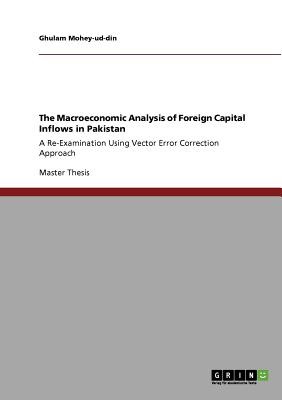
- We will send in 10–14 business days.
- Author: Ghulam Mohey-ud-din
- Publisher: GRIN Verlag
- ISBN-10: 3640880455
- ISBN-13: 9783640880454
- Format: 14.8 x 21 x 1 cm, softcover
- Language: English
- SAVE -10% with code: EXTRA
The Macroeconomic Analysis of Foreign Capital Inflows in Pakistan (e-book) (used book) | bookbook.eu
Reviews
Description
Master's Thesis from the year 2008 in the subject Economics - Macro-economics, general, grade: A-, GC University (Department of Economics), course: M. Phil Economics, language: English, abstract: The topic of Foreign Capital Inflows (FCI) to Pakistan got much attention in empirical literature, but the existing literature on FCI about Pakistan mostly used the customary econometric tools like OLS, 2SLS, FIML and 3SLS for analysis. However, we know that most of the macroeconomic variables are non-stationary, which mandates the re-examination of the past studies using new time-series tools like cointegartion and ECM. Thus, the present book re-examines the macroeconomic role of Foreign Capital Inflows (FCI) in Pakistan through applying vector error correction model (VECM) on annual time-series data for the period of 1972-2006. The present study does not find any evidence for direct positive impact of aggregate FCI on GDP growth and Investment (capital formation). However, the study finds the positive (complementary) relationship between FCI and domestic saving, thus suggesting an indirect positive impact of FCI on GDP through supplementing domestic resources. These results seem contradicting i.e. positive relation with domestic savings but negative linkages with investment and growth. However, we can interpret it as that FCI is supplementing the domestic resources and there is a need and justification for FCI in Pakistan due the shortage of domestic savings. But, these inflows of foreign capital are not transforming in the productive investment and thus not boosting economic growth. As this study shows that most of FCI are of non-investment (non FDI) type and are concentrated in the selected non-export-oriented and less-employment-generating sectors. In addition, the present study finds that exchange rate depreciation and current account deficit causes more inflows of foreign capital in Pakistan. While FCI also results in increasing the import of goods and services in P
EXTRA 10 % discount with code: EXTRA
The promotion ends in 5d.14:41:18
The discount code is valid when purchasing from 10 €. Discounts do not stack.
- Author: Ghulam Mohey-ud-din
- Publisher: GRIN Verlag
- ISBN-10: 3640880455
- ISBN-13: 9783640880454
- Format: 14.8 x 21 x 1 cm, softcover
- Language: English English
Master's Thesis from the year 2008 in the subject Economics - Macro-economics, general, grade: A-, GC University (Department of Economics), course: M. Phil Economics, language: English, abstract: The topic of Foreign Capital Inflows (FCI) to Pakistan got much attention in empirical literature, but the existing literature on FCI about Pakistan mostly used the customary econometric tools like OLS, 2SLS, FIML and 3SLS for analysis. However, we know that most of the macroeconomic variables are non-stationary, which mandates the re-examination of the past studies using new time-series tools like cointegartion and ECM. Thus, the present book re-examines the macroeconomic role of Foreign Capital Inflows (FCI) in Pakistan through applying vector error correction model (VECM) on annual time-series data for the period of 1972-2006. The present study does not find any evidence for direct positive impact of aggregate FCI on GDP growth and Investment (capital formation). However, the study finds the positive (complementary) relationship between FCI and domestic saving, thus suggesting an indirect positive impact of FCI on GDP through supplementing domestic resources. These results seem contradicting i.e. positive relation with domestic savings but negative linkages with investment and growth. However, we can interpret it as that FCI is supplementing the domestic resources and there is a need and justification for FCI in Pakistan due the shortage of domestic savings. But, these inflows of foreign capital are not transforming in the productive investment and thus not boosting economic growth. As this study shows that most of FCI are of non-investment (non FDI) type and are concentrated in the selected non-export-oriented and less-employment-generating sectors. In addition, the present study finds that exchange rate depreciation and current account deficit causes more inflows of foreign capital in Pakistan. While FCI also results in increasing the import of goods and services in P


Reviews